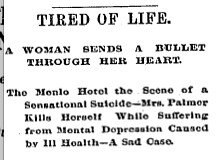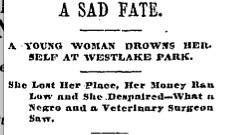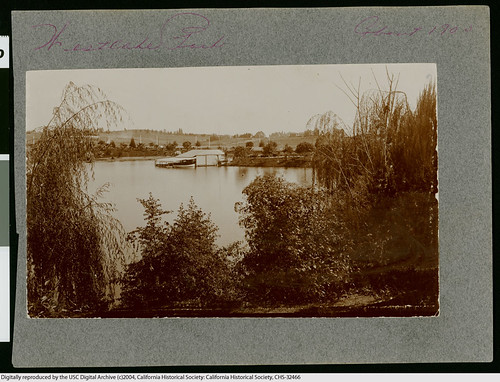The old Menlo Hotel, corner of Winston and Main, was the way station for many a visiting Angeleno, and the last exit for a few. The Menlo offered moderate weekly and monthly rates to appeal to the varied respectable folk who flocked to the growing city. Most of them are long forgotten, but it’s hard to feel badly about this obscurity. When the names are known, too often there’s tragedy attached.
Case in point, Mrs. Harriet Mortimer Palmer, aged 25. On the afternoon of April 10, 1890, she used a revolver to shoot herself through the heart in her room in the Menlo. Harriet and her husband, both invalids, had come from Toronto during the winter. They lived quietly in the hotel, he struggling with his heart disease and she with consumption.
In March, her condition worsened, but when Dr. T.J. McCarthy was called, she refused his care, and demanded to move into an adjoining room away from her spouse. Once alone, Mr. Palmer spoke candidly with the doctor, complaining that his wife’s nervousness and irritability were a torment, as were her regular threats to do harm to herself. The worry was impacting his own health.
On April 10, Mr. Palmer had a crisis, and the doctor came several times to attend to him. It was during one of these visits that a shot rang out in the next room, and when McCarthy rushed in, he found Mrs. Palmer dying, sprawled across the pillows she had heaped upon the bed to catch her as she fell. The bullet passed through her left breast, spine and shoulder, and was recovered about fifty feet down the hall. A note in her satchel read “I am thoroughly tired of life and so end it by my own hand. Please kindly send notice of my death to my aunt in Canada.” As for Mr. Palmer, he was reported to be in critical condition, and it was feared the shock of his wife’s death would kill him. But if it did, his passing did not make the papers. The maids came in and cleaned their rooms, and life at the Menlo went on.

Late one evening in March 1896, a respectable looking young woman in a gown of black, woolen brocade and a matching cape lined with salmon silk made her way out to Westlake Park. She removed her cape and hat, placed them neatly on a bench, and drowned herself in the lake. In the morning, her things were spotted by gentlemen walking in the park, and after a brief search, her corpse was found floating near the shore.
above: Westlake Park Boat House circa 1900, California Historical Society Collection, USC
Unidentified, her body was exhibited for most of the day in the undertaking parlor of Orr & Hines, where a stream of grim voyeurs trailed through, each pretending they hoped to give a name to the victim. In the afternoon, a friend finally gazed upon the face and knew it: William Davis, restaurant man, declared “This girl was until recently my mother’s chambermaid at the Menlo Hotel. She left a week ago last Sunday, giving us no reason.”
In her purse was found a pawn ticket from Mr. Morris’ shop, showing that she’d left a watch under the name Nellie Emerson. This was the name the Davises first knew her by, although over the five months of her employment they had accidentally found that she was really called Minnie Judy. Minnie was 24 with family in the Northwest, and had been out on her own since the age of 16. She was described as unfailingly good natured, so her departure and apparent suicide were a mystery.

Two men came forward with stories of having seen the girl before her fatal plunge. Veterinarian R.T. Whittlesay, offices on Broadway near Seventh (just a block from the funeral home where she lay on display), remembered a sad face gazing into his window on Tuesday night and was certain it was she. And an unnamed colored man who worked in a Winston Street corral and had known her for a year claimed he saw Minnie Judy the night of her death coming out of the old Los Angeles Theater with a dashingly dressed, dark-haired man. He said he heard the man suggest they catch a cab, as the last streetcar had passed. But officials had doubts about this tale, as the witness described the girl as wearing a large, feathered hat, not the small, modest one found on the bench in the park.
Why would a girl drown herself in 1890s Los Angeles? We have the usual suspicions. Had she been “ruined” by some cad, or did she have an inner sadness she didn’t show to other people? Was she really out at the theater with an unknown man the night she died? We’ll likely never know. But spare a moment to remember this poor lost girl of the city, and Messers Walters, Irving, Holt and Canserd whose morning constitutional was shattered by their discovery of the waterlogged lass, and the hundreds who took a few moments of their day to gaze upon a dead, drowned face for their amusement. And remember too the old Menlo Hotel, which was briefly home to thousands of anonymous souls, and to a very few whose names we know.


